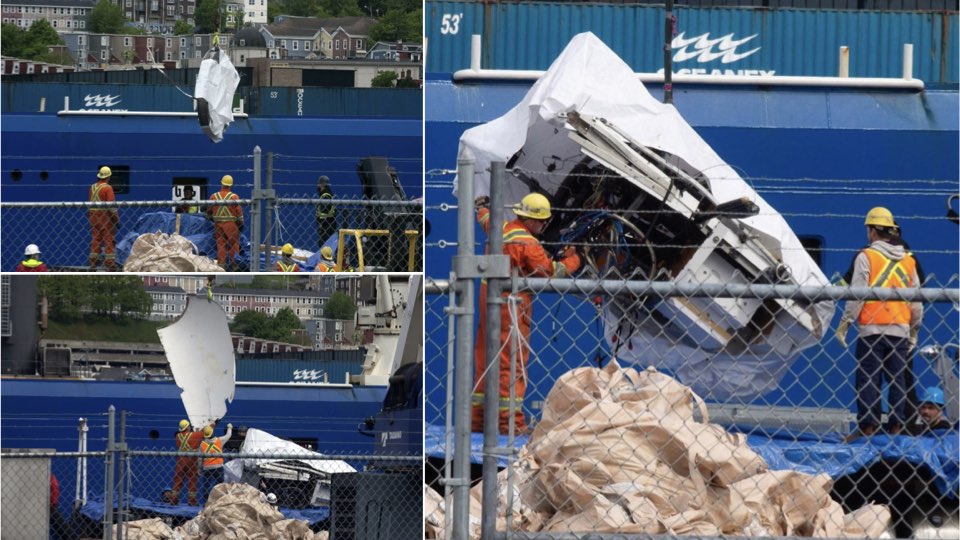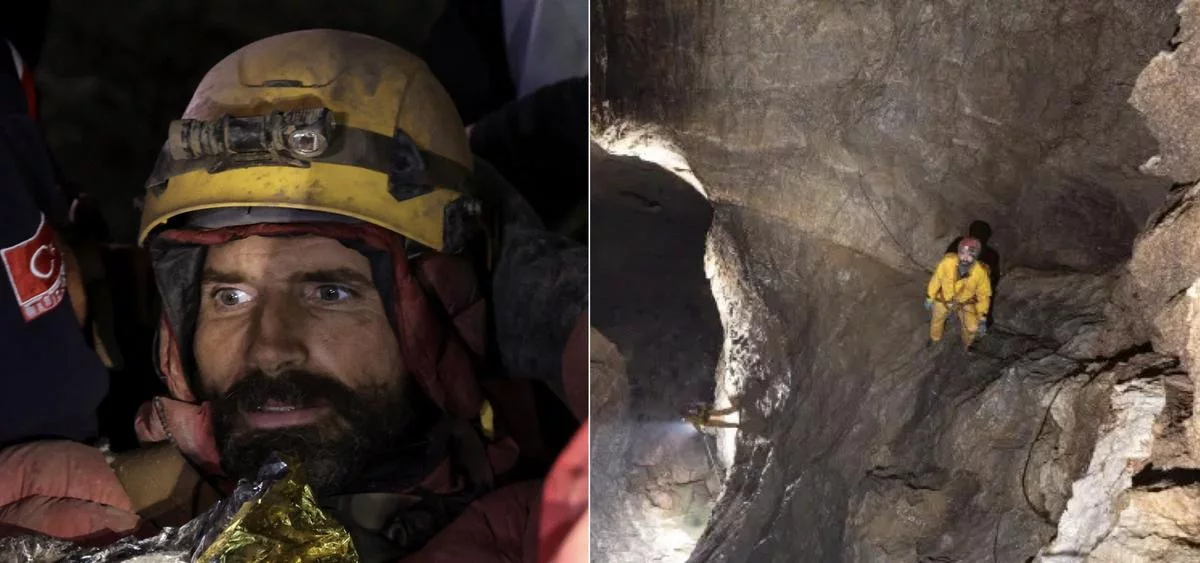Presumed human remains and debris from the tourist submersible that met a tragic fate during an undersea implosion have been recovered. The recovered evidence is being analyzed to understand the cause of the accident and shed light on this catastrophic incident.

Photo Credit: Twitter
In a tragic turn of events, presumed human remains and wreckage from the tourist submersible that imploded in the depths of the ocean, claiming the lives of all five individuals on board, have been retrieved from the ocean floor and transported to Canada, according to the United States Coast Guard.
The shattered remnants of the submersible, named Titan, were carried to St. John’s, Newfoundland, on the Canadian vessel Horizon Arctic. This location is approximately 400 miles north of the accident site where the catastrophic incident occurred. The evidence, including the possible human remains, will be further examined and tested by a marine board of investigation, which has been convened by the U.S. Coast Guard for a formal inquiry into the loss of the Titan.
BREAKING: OceanGate still advertising Titanic trips after “catastrophic implosion” of Titan sub which left 5 dead 😳 pic.twitter.com/A2qvUpVTFN
— Daily Loud (@DailyLoud) June 30, 2023
Medical professionals from the United States will also conduct a thorough analysis of the presumed human remains that were carefully recovered from within the wreckage at the incident site. Although the nature and extent of the possible remains have not been specified, video footage from the Canadian Broadcast Corp. revealed fragments of the submersible, including its nose and shattered pieces, being lifted from the Horizon Arctic’s deck by a crane. The damaged hull and machinery were also observed being unloaded at St. John’s, the starting point of the ill-fated expedition to the Titanic.
The examination of the debris is expected to provide crucial insights into the cause of the implosion that occurred earlier this month as the Titan, measuring 22 feet in length, was making its way to the century-old Titanic wreck in the North Atlantic. Concurrently, Transportation Safety Board of Canada (TSB) is conducting its own inquiry. Preliminary interviews have been conducted with the crew of the Titan’s surface support vessel, Polar Prince, and the voyage data recorder of the support vessel has been seized.
Fragments of the wrecked vessel were discovered scattered over the bottom, about 1,600 feet from the bow of the Titanic catastrophe, four days after the submersible lost communication with the Polar Prince. The international search operation, which had drawn worldwide attention, came to a halt when the fate of the five people onboard was sealed. Among those killed were Stockton Rush, the Titan’s submersible pilot and CEO of OceanGate Expeditions, as well as British millionaire Hamish Harding, Pakistani-born businessman Shahzada Dawood and his son Suleman, and French oceanographer Paul-Henri Nargeolet.
Debris and presumed human remains from the Titan submersible have been recovered and returned to land, the U.S. Coast Guard announced Wednesday, nearly a week after a search-and-rescue operation ended and the vessel’s five passengers were presumed dead. https://t.co/6NJiKLON93 pic.twitter.com/YGo9xmwuMO
— The New York Times (@nytimes) June 28, 2023
This devastating incident has raised concerns about the lack of regulation surrounding such expeditions and OceanGate’s decision to forgo third-party industry review and certification for the unique design of the Titan. Pelagic Research Services, the organization responsible for the recovery of the debris, expressed that their team had completed offshore operations but was still in the process of demobilization from the Horizon Arctic.
As the investigation continues and the debris is meticulously examined, the recovery of the presumed human remains and the shattered remnants of the Titanic submersible serve as a stark reminder of the risks associated with deep-sea exploration and the need for enhanced safety measures in this unregulated field.
Ed Cassano, CEO of Pelagic Research Services, became emotional as he described the transition from a rescue mission to a recovery operation during a news conference. The team had been dedicated to finding the submersible and rescuing its crew. However, upon reaching the seafloor near the Titanic wreck, their hopes were quickly shattered.
“Shortly after arriving on the seafloor, we discovered the debris of the Titan submersible. By 12 o’clock, a rescue turned into a recovery,” Cassano explained, his voice choked with emotion. Apologizing for the loss of life, he acknowledged the profound impact the incident has had on the families and loved ones of the victims.
Debris from the Titan was discovered less than a third of a mile from the wreck of the Titanic on the ocean floor. https://t.co/FFlbJmnNyM
— GBH News (@GBHNews) June 30, 2023
The recovery operation was carried out meticulously, with the crew of the Horizon Arctic using a specially designed crane to carefully lift the shattered remnants of the submersible from the ocean depths. Fragments of the vessel, including its nose and various shattered pieces, were lifted one by one and placed on the deck of the Canadian vessel. The damaged hull and machinery were also unloaded, providing crucial evidence for the ongoing investigations into the cause of the implosion.
Video footage captured by the Canadian Broadcasting Corporation showed the haunting scenes as the broken pieces of the Titan were brought to the surface. The once-promising submersible, designed to explore the depths and capture the world’s fascination with the Titanic wreck, now lies in ruins. The recovered debris would serve as a tangible reminder of the dangers and risks inherent in deep-sea exploration.
While the focus of the investigations remains on determining the cause of the implosion, questions have been raised about the lack of regulations and oversight in the field of deep-sea exploration. OceanGate Expeditions, the company behind the ill-fated mission, had chosen to bypass third-party industry review and certification for the unique design of the Titan. This decision, along with other factors, will likely be scrutinized as part of the inquiries to prevent similar incidents in the future.
Canada’s Transportation Safety Board has initiated its own inquiry, running parallel to the U.S. Coast Guard’s investigation. The preliminary interviews with the crew of the support vessel, Polar Prince, have already provided some initial insights into the events leading up to the submersible’s implosion. Additionally, the voyage data recorder of the support vessel has been seized, potentially containing valuable information about the conditions and activities preceding the incident.
As the shattered remains of the submersible and the presumed human remains make their way to Canada, medical professionals will conduct a thorough analysis to determine their nature and extent. This process will require meticulous examination and testing to identify and understand the recovered remains. The results will not only aid in the identification of the victims but also contribute to the investigation into the implosion and its causes.
US Coast guard claims to have recovered "Human Remains" from Titan Submarine…
— nick moseder (@TheNickyMo) June 29, 2023
US Coast Guard ALSO says the debris is consistent with a “catastrophic implosion.”
How is this possible?
Wouldn’t their bodies be completely liquified from the "catastrophic implosion"? pic.twitter.com/aQx6EMExuB
The recovery of the presumed human remains and the shattered remnants of the Titanic submersible has sent shockwaves through the deep-sea exploration community and the general public alike. It serves as a stark reminder of the inherent risks associated with venturing into the depths of the ocean. The tragedy underscores the need for enhanced safety measures, regulations, and industry standards to ensure the well-being of those involved in deep-sea expeditions and prevent similar accidents in the future.
When the Titanic went down in 2022, reporter David Pogue was on board the surface ship and couldn’t find it. Pogue’s CBS News Sunday Morning broadcast from December 2022, in which he questioned Titan’s safety, went viral on social media after the submersible lost communication with its support ship in June 2023. According to the story, Pogue told Rush, “It seems like this submersible has some elements of MacGyver jerry-riggedness.” He said that the submersible was steered and pitched using a $30 Logitech F710 wireless game controller with modified control sticks, and that construction pipes were utilized as ballast.
In another 2022 trip to the Titanic, one of the thrusters was placed backwards, causing the submersible to spin in circles as it attempted to go forward near the sea bottom. The problem was solved by steering while holding the gaming controller sideways, as seen in the BBC documentary Take Me to Titanic.
According to court documents dated November 2022, OceanGate alleged that during a 2022 dive, the submersible experienced battery troubles and had to be manually connected to a lifting platform, causing damage to exterior components. The journey was scheduled for early 2023.
Rush approached Las Vegas businessman Jay Bloom and offered him and his son two cheap tickets for the trip. The billionaire was given $150,000 per seat rather than the whole $250,000, with Rush arguing that it was “safer than crossing the street,” but Bloom declined the offer due to safety concerns. The journey was supposed to take place in May, but inclement weather forced it to be postponed until June.
As the investigations continue, experts from various fields, including engineering, marine science, and safety regulations, will collaborate to unravel the mysteries surrounding the implosion of the Titan. The findings will not only provide closure to the families and loved ones of the victims but also contribute to the development of improved safety protocols and standards for deep-sea exploration. Only through such measures can the risks be mitigated, allowing future expeditions to safely explore the wonders hidden beneath the ocean’s surface.
WEB STORIES FOR YOU
Stay connected with Today On Globe for the latest Global Issues and News Updates.
Explore more related articles at [TOG News / TOG Article]























